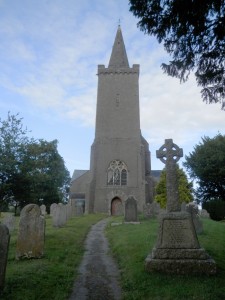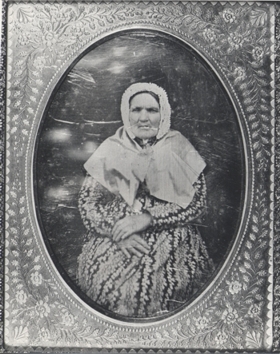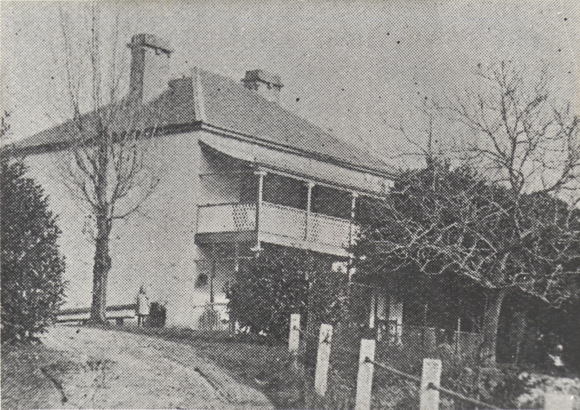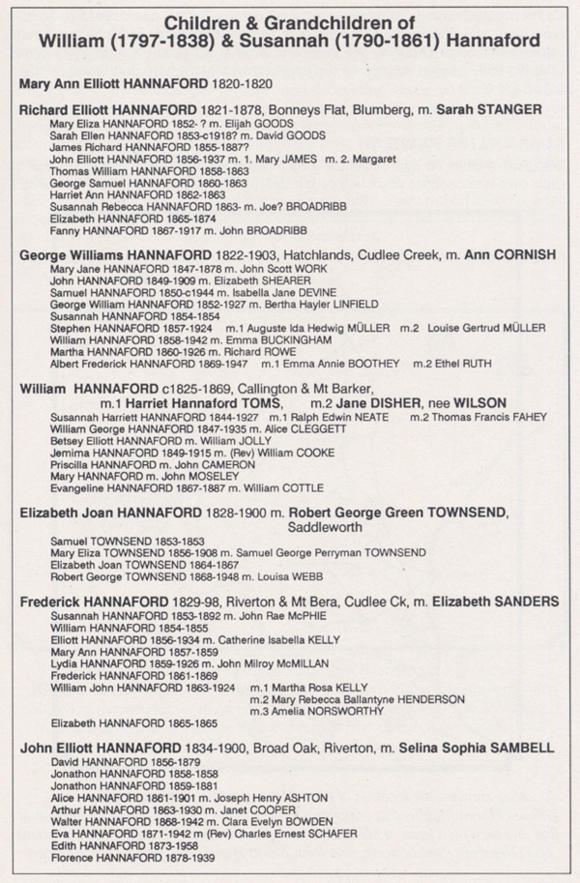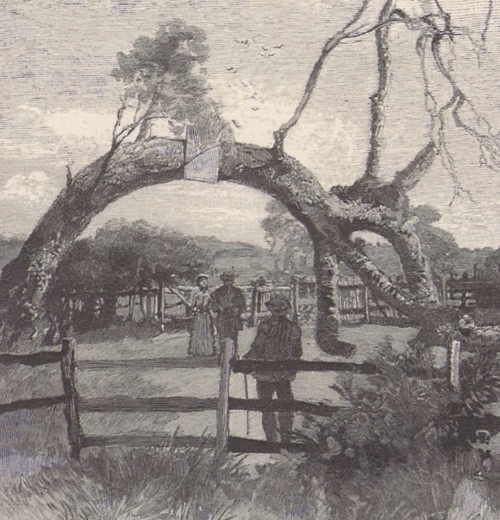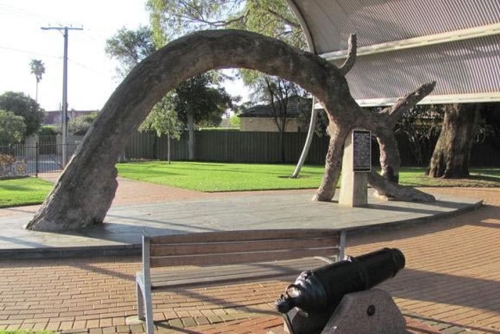My First Hannaford Family in Australia
For Australia Day this year I decided to write about the Hannafords, who are one of my immigrating families. Or more specifically I should say, about Susannah Hannaford (nee Elliott), who is truly the matriarch of the family, and her children.
I admit I am in awe of Susannah, in some ways anyway. She was a widow by age 48, not an easy thing for anyone, but then to pack up all of your belongings and move to the other side of the world, to a colony that had only been founded a few years before, with her six children, leaving her family, friends and whole life behind, to start again from scratch. I can’t even begin to think of what that would be like or how she managed it. But she survived. So did her children, and now her descendants number the thousands.
But let’s go back a little bit first.
Back in Devon …
Susannah Elliott was born in 1790 in the market town of Totnes, in Devon, England. Meanwhile the Hannaford family (the ones I’m writing about anyway), grew up just four miles away in the little town of Rattery. I mention that as the Hannaford name in Devon is much like Smith or Brown everywhere else. Hannafords are everywhere!
When Susannah was 30 years old, she married William Hannaford (one from the neighbouring parish in Rattery), and who was actually a few years younger than her. Sadly William died at age 42, leaving Susannah with six children ranging in age from 17 down to 6.
Devon at that time (actually probably England at that time) had limited employment opportunities, and with high taxes (land tax and window tax for instance), it would seem that emigrating to a new land offered better prospects than staying in Devon.
The Voyage and Arrival …
So in 1840 Susannah and her clan together with 164 other passengers, boarded the “Brightman”, which was a three-masted barque which sailed from London, to Plymouth, and on to South Australia, making a quick voyage in just 106 days. Again, I can’t envisage what that would have been like. The closest I’ve been to this is a large cruise ship for 21 days which doesn’t even vaguely compare in any way whatsoever!
The Verco’s were also aboard the Brightman, and the following is an extract from the “Early Recollections of Sir Joseph Verco” which was written around 1930.
“The Brightman was a dry and comfortable ship. The bunks were arranged athwart ships along the sides of the vessel leaving a passage down the middle of the ‘tween decks. If in bed the passengers had to shift pillows from one end of the bunk to the other else he would be lying with his head down and his feet at a much higher level. Captain Nockells was a religious man conducting regular Sunday services, and he never failed to close with Psalm 139 verses 7-12. He would then invoke the blessing of God on the ship and those within, followed by the benediction. The Brightman made good passage of only 106 days. Keeping as much to the eastward as possible on the way south to avoid the dreaded Cap San Roque and its leeward currents. They sailed close round the Cape of Good Hope, then well to the north … and anchored in Holdfast Bay on 10 December 1840.
From the time of anchoring to the time of departure from the ship, there was a delay of seven days for some passengers. Boats transported the passengers and their luggage to land. Many floatable articles, such as wooden framed houses, manufactured and packed in England for immediate erection on landing in Australia, were simply tossed overboard and then tided to shire. All this took time and meant a long and tedious wait onboard for passengers.
When not concerned with the activity going on around them, those onboard found themselves preoccupied with thoughts of what awaited them beyond the shores amid the dense forest of trees and scrub … As it was they could see hundreds of natives moving along the shoreline. More than once they had been startled by the noise of a corroboree, one of which had been followed by fierce fighting resulting in many naked warriors being speared to death. Even at a distance it was somewhat frightening, but still more unnerving had been the screaming and yelling of the lubras as they mourned their dead.”
From the ship at Holdfast Bay (now Glenelg) it was a case of making the trip to Emigration Square in Adelaide, approximately 12 kilometers away, and with no roads. For many it was a case of walking the trip while for others they travelled by bullock dray. Emigration Square, situated on the Parklands, just west of Hindley Street contained 30-40 wooden huts in 1839-40, which were made for newly arrived emigrants to have a place to stay until they moved on.
Settling in South Australia …
The records show that the first house Susannah bought in South Australia was a 2 acre property at Unley in 1841. This was a small cottage and she established a mini farm on the land. By this time her two oldest two sons, Richard and George, went off cattle herding for the South Australian Company. And no doubt it was during one their travels that they heard of “fertile land with springs and running water 25 miles from Adelaide”. So George and his friend from the ship, James Verco, set out to find this land, and found it at Cudlee Creek, in the Adelaide Hills.
George was impressed with it, so much so that Susannah immediately bought land there, and in 1849 had a cottage built from stone quarried on the property. They named this property “Hatchlands” after the family property in Devon “Hatchland”. And this was the start of the Hannaford’s at Cudlee Creek. And today (six generations and 168 years later), they are still in the region.
As her family grew up and got their own properties, you will find descendants of Susannah’s living at Bonney’s Flat, Birdwood (Blumberg), Riverton, Saddleworth and of course Cudlee Creek (all in South Australia). And some of the property names associated with the family are ‘Broad Oak’, ‘Mount Bera’, ‘Riverside’, ‘Dingo Vale’, ‘Wattle Vale’, ‘The Briars’ and ‘Greenhills’.
The Hannaford’s have been heavily involved in the Fruitgrowers and Agricultural Associations for many years, and were known for their top class and prize winning apples. Some even winning international prizes. And I’m proud to say that today there are still family members running these generations-old apple orchards.
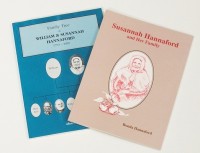 Of course Susannah and her family’s story doesn’t stop there. There are many achievements and noteworthy things from numerous descendants, but it’s too much for this post. But for anyone that does want more info on the family, I suggest getting a copy of both the following books, as they contain plenty of detail:
Of course Susannah and her family’s story doesn’t stop there. There are many achievements and noteworthy things from numerous descendants, but it’s too much for this post. But for anyone that does want more info on the family, I suggest getting a copy of both the following books, as they contain plenty of detail:
– Susannah Hannaford and her Family
– The Family Tree of William and Susannah Hannaford 1790-1990
This chart below shows Susannah and William Hannaford, their seven children (the first one died in infancy), together with their grandchildren. Seeing this you’ll understand WHY there are so many Hannaford’s around now.
Susannah Hannaford (1790-1861)
Truly a pioneer
And the matriarch of an incredible clan
180, and Still So Young!
Happy Birthday South Australia! 28th of December. The day that my beautiful homestate celebrates its birthday, and today it turns 180.
And while 180 is ancient in human terms, for the age of place it’s really only a baby. But even so, in those 180 years, the colony (and now State) has seen so many remarkable achievements throughout the years.
But first South Australia’s birthday is officially called “Proclamation Day“, and Wikipedia says …
“Proclamation Day in South Australia celebrates the establishment of government in South Australia as a British province. The proclamation was made by Captain John Hindmarsh beside The Old Gum Tree at the present-day suburb of Glenelg North on 28 December 1836.“
John Hindmarsh, who became the first governor of South Australia arrived in South Australia on the “Buffalo”, on 28th December 1836, and when he stepped ashore at Holdfast Bay (near the Old Gum Tree), he read the proclamation.
Each year re-enactments of the events of South Australia’s founding are still held on the same day, by the remains of the same Old Gum Tree. The proclamation calls upon the colonists to “conduct themselves with order and quietness,” to be law-abiding citizens, to follow after industry, sobriety, and morality, and to observe the Christian religion. By so doing, they would prove to be worthy founders of a “great free colony.” You can read the full proclamation on the Adelaidia site.
The People …
As with any place, South Australia has many men and women of ‘note’. Those who’ve made an impact on the State in various ways, and you’ll find many of these mentioned in the 150 Great South Australians post (see links below), but obviously the list is confined to 150, with others who should make the list as well, but their achievements are incredible.
150 Great South Australians – Part 1 A-I
150 Great South Australians – Part 2 J-Z
The Events …
As for key events that have happened in South Australia, there’s so many … but here’s a small sampling for you.
1627 – First recorded European sighting of the South Australian coast.
1802 – South Australian coastline mapped by Matthew Flinders and Nicolas Baudin.
1836 – South Australia proclaimed by Governor John Hindmarsh on 28 December at the Old Gum Tree, Glenelg.
1836 – Site for Adelaide chosen by Colonel William Light beside the River Torrens.
1837 – Adelaide’s first hospital opens on North Terrace.
1838 – The first Australian police force is formed in Adelaide, the South Australia Police.
1839 – The first road in South Australia, Port Road, is opened.
1840 – Royal Adelaide Show held for the first time.
1848 – Pulteney Grammar School established.
1850 – The forerunner to Harris Scarfe, G. P. Harris and J. C. Lanyon, opened on Hindley Street.
1858 – Melbourne-Adelaide telegraph line opened.
1858 – The first edition of The Advertiser newspaper is published.
1859 – A jetty of more than 350 metres in length is constructed at Glenelg.
1861 – East Terrace markets opened.
1861 – Copper discovered at Moonta, on the Yorke Peninsula.
1865 – Bank of Adelaide founded.
1870 – Port Adelaide Football Club established.
1872 – The General Post Office opened.
1873 – First cricket match played at Adelaide Oval.
1878 – First horse-drawn trams in Australia commenced operations in the city.
1880 – Telephone introduced in South Australia.
1881 – Coopers Brewery is established.
1883 – Adelaide Zoological Gardens opened.
1885 – The Adelaide Arcade opens.
1895 – South Australia was the first Australian colony to grant women the right to vote, and the first in the world to allow women to stand for Parliament.
1901 – Adelaide became a state capital upon the establishment of the Commonwealth of Australia on 1 January.
1904 – Adelaide Fruit and Produce Exchange opens in the East End.
1914 – South Australian troops join their Australian comrades in Europe to fight in the Great War.
1915 – Liquor bars close at 6 pm following referendum, creating the six o’clock swill
1924 – Radio broadcasting begins.
1927 – Duke and Duchess of York visit.
1933 – First John Martin’s Christmas Pageant.
1935 – Many German place names, which had been changed during the Great War, are restored.
1937 – First permanent traffic signals installed.
1939 – Worst heat wave recorded with disastrous bushfires and highest Adelaide temperature of 47.6° Celsius.
1940 – Birkenhead Bridge opens.
1942 – Rationing of tea and clothing introduced.
1948 – Holden begins production.
1954 – Adelaide is hit by an earthquake causing much property damage but no loss of life.
1954 – Queen Elizabeth II makes first sovereign visit to Adelaide.
1954 – Mannum-Adelaide pipeline completed, pumping water from the River Murray to metropolitan reservoirs.
1955 – Adelaide Airport at West Beach opens.
1958 – First parking meters installed.
1977 – Late night shopping commences.
1982 – International air services begin at Adelaide Airport.
1989 – The Bicentennial Conservatory, referred to as “The Big Pasty”, opens at the Botanic Gardens.
More Information …
For further information on South Australia’s history, be sure to check out the following:
Wikipedia Timeline of South Australia’s history
South Australia’s Timeline: The First Hundred Years of Colonisation
Homeopathy and the Treasures Between the Pages!
Homeopathy: “The study of natural therapy which stimulates the body’s immune system to restore health”. It was something that my great grandpa, J.B. Randell taught himself.
Ever looked through an old book and found something slotted in the pages in between? I have. Regularly. I’ve mentioned before that my mum’s side of the family weren’t one’s to throw things out. Putting it nicely “hoarders”, and for that I’m eternally grateful, as it has meant that we have SO MANY family heirlooms dating back generations, it’s truly amazing.
One thing that seems to have been a ‘thing’ that’s been passed down through the generations of Randell’s, was the habit of putting things in the middle of books. I’ve always known my grandma to do that, and have often discovered random newspaper cuttings, birthday cards, flattened Easter egg wrappers and more in the pages of books of hers. Now this book of her fathers, John Beavis “JB” Randell (to my surprise) has even more bits filed in between the pages.
I found a total of 25 items in amongst the pages of the book, and I have scanned each one of them, and that’s what I wanted to share with you today. Some are interesting, others not. But from there there are clues which could lead to further research …
[espro-slider id=9875]
As you will see there’s a collection of all sorts, from receipts, to newspaper cuttings, to bible verses, envelopes, hair, leaves, a bookmark and other printed items. I’ve noted them below, as the caption on the slider was so tiny it wasn’t readable.
1. Gumeracha Town Hall Concert, 9 August 1924
2. Receipt from Norsworthy’s store, Gumeracha, dated 9 September 1924
3. Dried leaves
4. Hair or fur
5. More dried leaves
6. front of homeopathic remedies brochure
7. advert for Nurse Grace’s ointment
8. Receipt of the sale of rabbit skins by Restyn Randell, dated 2 May 1922
9a. Front of bible verse card for Restyn Randell
9b. Back of bible verse card for Restyn Randell
10. advert for Dr Ricords Interesting Book for Men
11. “Forget Me Not” bookmark
12. Coats crochet cotton wrapper
13a. Front of Pulteney Street parking station ticket
13b. Back of Pulteney Street parking station ticket
14. British and Foreign Bible Society, Gumeracha, 15 September 1918
15. Journal of Department of Agricultre, Victoria addressed to J.B. Randell
16. Good citizenship leaftet, dated 11 February 1925
17. Envelope addressed to J.B. Randell, Kenton Park, Gumeracha
18. Birks Pharmacy letter
19. Handwritten notes
20. Postage paid envelope
21. ‘By Grace Ye Are Saved’ card
22. Readers Digest letter to D.A. Randell
23. Tag with list written on it
24a. front of Fruitgrowers Association of Gumeracha envelope
24b. back of Fruitegrowers Association of Gumeracha envelope
25. Receipt from Norsworthy’s Store, Gumeracha, for J.B. Randell dated November 1942
Now excuse me while I head off to the bookshelf, and start paging through more old books, to see what else I can find.
Christmas Day in Adelaide, and it’s (Another) Scorcher
“Adelaide set for hottest Christmas Day since 1945 as heatwave conditions hit South Australia”. That’s the headline on the ABC News website, and yet it’s not even the hottest Christmas Day that Adelaide’s had.

temperature for Adelaide Christmas Day 2016, as shown on Bureau of Meteorology website http://www.bom.gov.au/sa/forecasts/adelaide.shtml
A quick check on Trove lead me to an article in The Advertiser, dated 26 December 1945, part of which is below.
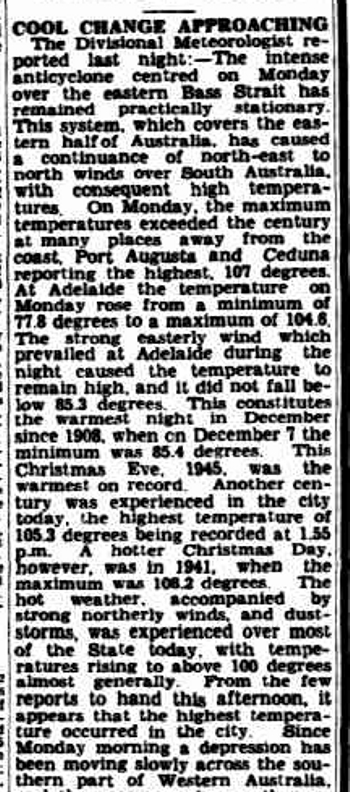
The Advertiser, 26 December 1945, p.6. http://nla.gov.au/nla.news-article48683583
This says that the top temperature in Adelaide on:
Christmas Eve, 24 December 1945 was 104.6F (40.3C)
Christmas Day, 25 December 1945 was 105.3F (40.7C)
But even these aren’t the highest. Go back further as we find even hotter Christmas Days.
Christmas Day, 25 December 1941 was 106.2F (41.2C)
And according to Dick Whitaker, on Dick’s Blog, the all-time top Christmas Day temperature record for an Australian capital city goes to Adelaide back in 1888, when the mercury soared to 107.9F (42.1C).
So while it’s not a regular occurrence, it’s not unheard of having a 40C+ Christmas Day temperature. But it’s still not fun for those who have to travel during the day, or who had planned an outdoor Christmas do. So my advice for those who are in Adelaide for Christmas in 2016, stay inside (as much as you can), stay cool, and try not to bake, roast or fry (yourself that is, not the Christmas dinner)!
Merry Christmas everyone!

